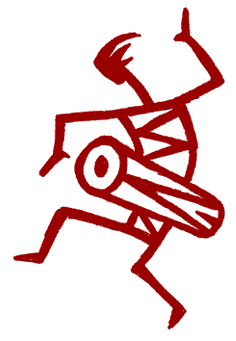

Thought of the Week Archives |
 |

|
|
|
July 7, 2003 Inner Conflict - Part 2: Subpersonalities When children can't be themselves for fear of punishment or neglect, they attempt to change and "act" in the ways that will please their parents. In this society, this is generally accepted as necessary "training" in order to whip "unruly," "unmannered," and "uncivilized" children into shape. Whether we like it or not, training makes children "act" differently than what they are. And an act is an act - it is a false set of behaviours that sits like a mask over the "face" of the person acting. In ancient Greek theatre, the actors wore masks with protruding, horn-shaped mouths to project their voices to the crowd. The mask was called a "persona," which means "through sound." Since that time, the word persona has been used to indicate the various acts or masks that we project over our true selves. In "civilized" society, acting is so rampant that we take it to be a normal part of human nature, and consider our "personality" (which is a false self) to be a good thing. We don't begin to question this false personality until we start having trouble knowing who we really are and what we really want out of life. Unfortunately, the training of children doesn't stop at the creation of one false personality. Children are often under so many different expectations that they create more than one mask. In fact, they usually create a main personality and a few other "subpersonalities." In the extreme, this personality splitting manifests itself as Dissociative Identity Disorder (DID) or what was popularly known as Multiple Personality Disorder. When things get this fragmented, the different personalities act without knowledge of the others. Needless to say, it is a debilitating condition. Fortunately, most of us don't experience this extreme. I have never met anyone who doesn't have at least two subpersonalities. If you've ever had an argument with yourself, you have experienced this phenomenon. Although this may seem normal, normal doesn't necessarily mean "healthy," it just means "common." Some illnesses are common, and this is one of them. Subpersonalities manifest themselves as patterns of behaviour that appear during different circumstances or times of stress, and are often characterized by differing behaviour patterns, trains of thought, or "thought voices." It is in moods and inner conflicts that subpersonalities are most easily witnessed. The different "mood" is often a subpersonality. When parts of us argue, these parts often have distinct tones, physical postures, and behaviours. These parts are also subpersonalities. It's usually easier to witness this phenomenon in others. That may be a good place to start! Subpersonalities were alluded to by: Freud in his theory of personality structures that included the id, ego, and superego; Eric Berne in his Transactional Analysis theory of the inner child, adult, and inner parent; Fritz Perls in his Gestalt theory of the topdog and underdog; Arthur Janov in his Primal theory of the real self and various false selves; Robert Louis Stevenson in his book The Strange Case of Dr. Jekyll and Mr. Hyde. It may be frightening to imagine that we are this split, or that we share similar traits with others who seem very ill. Unfortunately, this concept is unfamiliar because it has been kept hidden as a general cultural denial. In my experience, the discovery of my own subpersonalities was a tremendous relief. I finally understood certain aspects of my behaviour and was able to treat myself with compassion instead of the usual confusion and self-loathing. The word "heal" is from the Old English word "hal" and the Greek word "holos," which both mean "to make whole or complete." The word "religion" is made of the latin roots "re" and "ligare" (join) which means to re-join, bring together, or unite. These major concepts indicate a natural movement to connect things which have been split apart. When we are split into subpersonalities, it is our nature to move toward unity. We don't have to live this way forever. Since it is a lack of fundamental acceptance that forced us to split, it is acceptance of who we are, even in our illness, that will reverse the process. By accepting our subpersonalities, and expressing them in a safe setting, the conflicts between them can begin to dissolve. We have to take the broken pieces gently in our hands before we can begin to glue them together. |